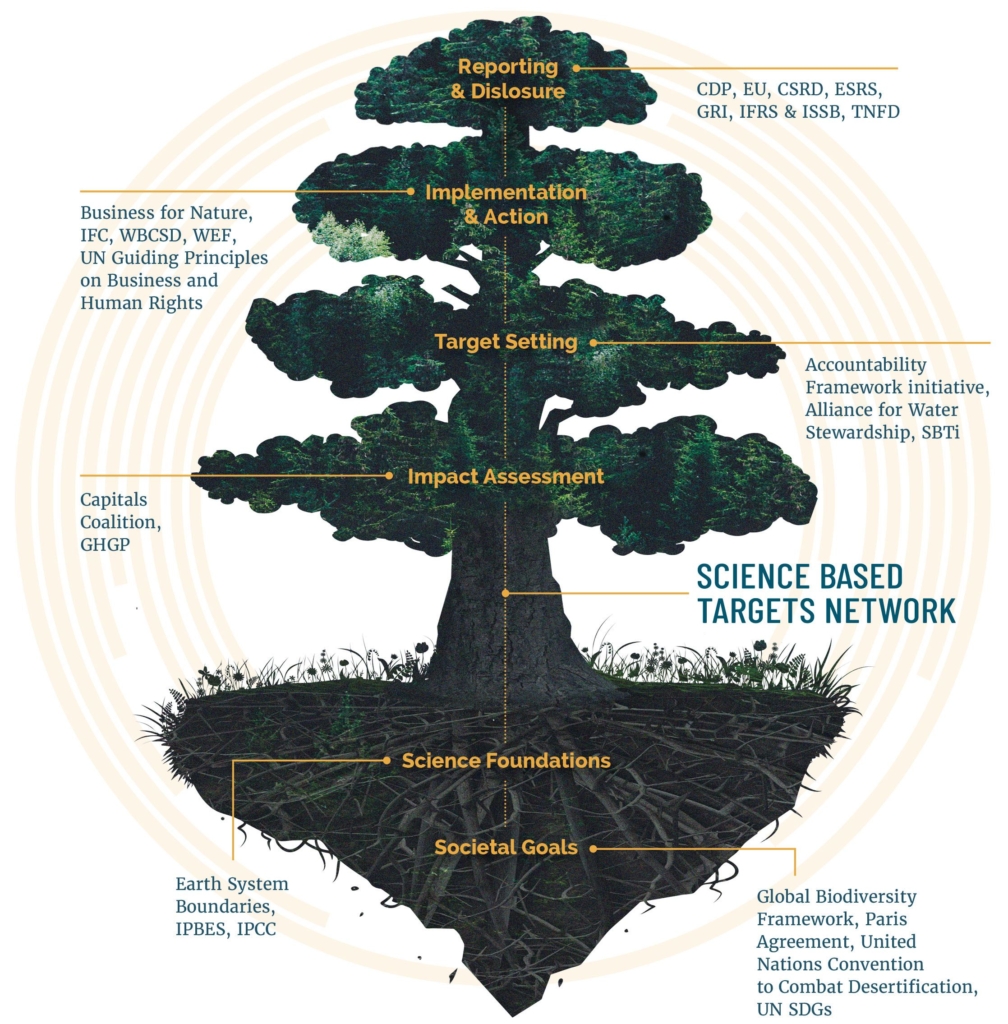
Guiding Companies For a Nature Positive Future: SBTN’s Interplay with Global Initiatives
Playing an integral role in helping companies take credible action to address their environmental impacts, the Science Based Targets Network (SBTN) highlights its interconnection with the broader ecosystem of global initiatives mobilizing business for a nature positive future.

Contributing to a nature positive future: the business imperative
An increasing number of companies recognize that halting and reversing nature loss is a critical business issue. This is prompting them to expand their focus beyond GHG emissions to comprehensively manage their environmental impacts and dependencies. Forward-thinking companies see this not just as risk mitigation but an opportunity for value creation including access to capital, competitive advantage and long-term business resilience.
SBTN’s approach to corporate impact management
At the Science Based Targets Network (SBTN), we help companies address their environmental impacts, across freshwater, land, biodiversity and ocean, alongside climate through the Science Based Targets initiative (SBTi). Led by environmental NGOs and rooted in the best available science on ecological thresholds and societal needs, the guidance produced by our network helps companies comprehensively quantify their environmental impacts across their operations and value chains and then move to precise and credible action at landscape-level.
This action is underpinned by targets directly linked to a company’s individual impact and grounded in environmental and societal materiality. As we guide companies through this journey, we are helping them answer the questions “how much action is enough, where and when?” based on what nature and people need to thrive. This in turn means companies can harness science-based targets for nature to boost their resilience and unlock commercial opportunities.
Alignment in action: collaborative partnerships
Amidst a proliferation of sustainability initiatives, our goal is to provide streamlined, prescriptive resources for corporate target-setting on environmental impacts that instills confidence and increases efficiency for companies.
For this reason, we have created a target-setting process that aligns with and builds on the most widely-used standards, frameworks, tools and data for impact assessment and reporting to increase efficiency for companies. For example, our impact assessment approach builds on the Greenhouse Gas Protocol and Natural Capital Protocol, as well as the standards from the IFRS and ESRS, providing consistent guidance for companies on the scope of business and issues they should cover. Note: All organizations listed using acronyms are explained in the table below.
Through our integration of best practices and creation of new approaches where necessary, our guidance also enables companies to make progress towards multiple sustainability objectives including leveraging their target-setting work to prepare data for submission to regulators, standards, and disclosure platforms. This becomes particularly crucial in light of increasingly ambitious nature regulations.
In many cases we form collaborative partnerships; frameworks like TNFD and GRI also now incorporate SBTN’s guidance, metrics and conceptual framework into their work, and other organizations like CDP is exploring future options for integration.
The table below explains in greater detail some of the key connections between SBTN and other sustainability initiatives through the lens of environmental impact management. Alignment between SBTN and other initiatives can take many shapes – from referencing relevant standards to co-development. This is not meant to be an exhaustive list, but rather to address the connections we’re most frequently asked about by companies and stakeholders.
| Organization / Framework | Relationship | Value for companies | Key areas of alignment |
| Science foundations | |||
| Earth Commission – Earth System Boundaries | SBTN and the Earth Commission are collaborating to inform how the new Earth System Boundary science can be translated for companies and cities into actionable target-setting methodologies in subsequent releases. | By setting and achieving SBTs for nature, companies will be doing their part to stay within ecological and social thresholds as outlined in safe and just Earth System Boundaries. | · The ambition of science-based targets for nature (‘how much corporate action is enough’) – specifically for freshwater and land |
| · Types of action recommended (use of the SBTN AR3T action framework*) to guide action on targets in natural and working systems (land and freshwater) | |||
| *Note that this work expands upon the well-known science of the planetary boundaries. | *Note this framework is built on the conservation mitigation hierarchy | ||
| Intergovernmental Science-Policy Platform on Biodiversity and Ecosystem Services (IPBES) | We draw on the work of the IPBES assessments and conceptual frameworks, to inform our method development, including the pressures (referred to in the IPBES framework as direct drivers) that science-based targets are addressing | Science-based targets for nature enable companies to address some of the primary pressures causing biodiversity and nature loss as identified by IPBES. | · Conceptual
framework for understanding how human/economic
activities influence the loss of nature |
| · Selection of core indicators to use for tracking pressures and loss of nature (states). | |||
| Intergovernmental Panel on Climate Change (IPCC) | Reports from the IPCC are used to inform our recommendations on response options, ambition levels and categories for measurement and reporting (e.g. land use types). Key IPCC reports referenced in our work include the special report on land. | Confidence that SBTs for nature integrate the best-available science across domains including climate. | · Response options as highlighted in the IPCC reports and SBTN annexes to the Step 3 methods |
| · Focus on sectors of agriculture and forestry as key for nature and climate action | |||
| · Critical dates for target attainment | |||
| · Key metrics for a holistic view of issues: water availability, soil erosion, vegetation loss | |||
| Societal goals | |||
| Kunming-Montreal Global Biodiversity Framework (GBF) | We are taking the goals, targets, indicators, and ambition levels from the Convention on Biological Diversity’s GBF and designing our methods (Step 1-5) to enable corporate contribution to the societal objectives outlined in this framework. | SBTs for nature are the key mechanism for companies to align with and contribute to the global targets in the GBF, including targets 1, 2, 7, 8, 10, 11, 14, and 15. | · Ambition levels for targets* |
| · Metrics and indicators for tracking progress against targets.* | |||
| *These are not always directly applicable to companies and require translation by SBTN in order to be incorporated into our methods and guidance. | |||
| Paris Agreement (UNFCCC) | We support the attainment of climate goals by requiring GHG emitters to set SBTs for climate and by enabling the protection and enhancement of carbon sinks with SBTs for nature. | Pre-alignment of companies’ climate and nature strategies and a minimization of trade-offs between these agendas. Through use of our methods and guidance, companies can unlock greater synergies and efficiencies in their attainment of climate and nature goals. | · Ambition levels for state outcomes based on social and economic needs – the Paris Agreement is pinned to 1.5C because of what this level of warming means for humanity |
| United Nations Convention to Combat Desertification (UNCCD) | Core members of the SBTN Land Hub collaborate closely with the UNCCD. The indicators used by the SBTN Land Hub are aligned with those used by UNCCD to track achievement of Land Degradation Neutrality (LDN) at the national level, and serve to incentivize corporate actions in alignment with those needed to achieve government commitments to achieve LDN. | Alignment of corporate actions with national-level commitments to achieve LDN set through the UNCCD (Strategic Objective 1 of UNCCD). | · Indicator framework for land targets closely aligned with indicators used to track achievement of LDN and SDG Target 15.3 |
| · Achievement of global benefits through avoiding, reducing, and reversing land degradation (UNCCD Strategic Objective 4) | |||
| · Focus on landscape-level action and planning aligned with UNCCD support for integrated land use planning. | |||
| United Nation Sustainable Development Goals (UN SDGs) | We draw on the SDGs to inform the ambition levels and areas of action required in corporate targets. | Corporate science-based targets for nature can enable companies to contribute toward SDGs 6, 13, 14, and 15. | · Integrated approach to target setting and action based on the need to address corporate impacts through a socio-environmental lens |
| Impact assessment | |||
| Capitals Coalition – Natural Capital Protocol, Align Project, Transparent Project | SBTN and the Capitals Coalition provide technical advisory support to one another for ongoing projects. In our methods, we draw on the Capitals Coalition’s conception of the environmental impact assessment process, and best practice for how to assess nature-related topics. | SBTN methods build from these frameworks to provide more prescriptive and quantitative methods for impact assessment and management that provide greater consistency for corporate end users and clarity for investors and regulators. | · The basic steps of assessing nature-related impacts |
| · The core indicators to be included in an assessment of nature-related impact (including pressures, and states). | |||
| Greenhouse Gas Protocol (GHGP) – Corporate Standard, Scope 3 Standard, and Land Sector and Removals Guidance | We draw on the GHGP standards as the foundations
for accounting embedded in our Step 1: Assess method. When climate is identified as material, companies are recommended to use the Corporate Standard and Scope 3 Standard to assess climate impacts. If companies have land-based climate emissions, they are recommended to use the GHGP Land Sector and Removals Guidance to calculate their land footprint (in Step 3), when using statistical data. |
· The approach to defining the business scope for assessment and target setting (GHGP for climate and land) | |
| · Recommendations for gathering and structuring data for reporting and disclosure (GHGP climate) | |||
| · Basic location and activity data needed to fulfill GHGP Land recommendations and SBTN methods. | |||
| Target setting | |||
| Accountability Framework initiative (AFi) | We draw on AFi for its guidance on elimination of deforestation, ecosystem conversion, and human rights abuses from commodity supply chains. | SBTN provides an integrated and comprehensive approach to target-setting, which ensures that companies address all material issues, for all parts of their business that negatively affect nature. | · Key definitions (e.g. of deforestation and no conversion) |
| · Guidance on timelines and best practice for zero deforestation and supply chain management | |||
| · Basic location and activity data needed to fulfill AFi recommendations and SBTN methods. | |||
| Alliance for Water Stewardship (AWS) & AWS Standard | We draw on AWS for its guidance on corporate and local stakeholder engagement in target-setting at site level. | · Desired freshwater outcomes and indicators for setting targets and monitoring progress | |
| · Response options for achieving targets. | |||
| Science Based Targets initiative (SBTi) – Including the sector guidance for companies operating on forests, land and agriculture (FLAG) | We draw on SBTi as the best available methods
companies can use to manage their climate impacts. If material, companies are required by SBTN to use SBTi methods to manage climate impacts through science-based targets, both for industrial and land-based emissions. |
· Science evaluation and review processes | |
| · Defining the business scope for assessment and target setting (i.e. the organizational boundary) | |||
| · Basic location and activity data needed to set SBTi FLAG targets and SBTN land targets (no conversion and footprint reduction) | |||
| · Pairing requirements and recommendations on deforestation and conversion in order to support global goals. | |||
| Implementation and action | |||
| International Financial Corporation (IFC) – Performance standards | We draw on the performance standards of the IFC as a key resource used by private sector organizations, including those seeking or benefiting from IFC financing, to ensure compliance with environmental and social best practices. | SBTN embeds these principles and standards within the central guidance for impact management and target-setting, ensuring that they are core to companies’ use of the methods. | · Basic principles with respect to human rights in labor chains and as local stakeholders |
| · Core criteria to ensure avoidance of impacts to biodiversity and remediation of these at site level. | |||
| UN Guiding Principles on Business and Human Rights | We draw on the UN Guiding Principles as internationally-recognized best practice on social issues, which companies are referred to in sections throughout our methods and Stakeholder Engagement Guidance. | · Guidelines / requirements and recommendations for local stakeholder engagement | |
| Sector Actions for Nature (Business for Nature, WBCSD, & WEF) | SBTN has collaborated with the partners that produced these 12 sector-specific guides to ensure that their recommendations are in line with what is needed to achieve SBTs for nature. | A quick snapshot of the impacts and dependencies most common for each sector covered and confidence that by taking the actions recommended they can prepare, set, and meet their SBTs. | • Impact categories covered align with SBTN pressure categories |
| • Value chain stages covered: Recommendations cover upstream and direct operations | |||
| • Differentiated guidance based on value chain position | |||
| • Types of response options highlighted, following the SBTN AR3T action framework | |||
| Reporting and disclosures | |||
| CDP | In our methods, we draw on CDP to establish what data companies are likely to have (e.g. for specific supply chains and impact indicators). | Data collected for target-setting with SBTN can be leveraged for reporting to CDP. | · The organizational boundaries and activity categories used to complete the SBTN assessment and CDP reporting |
| · High impact commodities which must be included in CDP reporting and SBTN assessment | |||
| European Union* – Including Corporate Sustainability Reporting Directive (CSRD), Non-Financial Reporting Directive (NFRD) and European Sustainability Reporting Standards (ESRS), as well as other environmental regulation from the EU (e.g. on deforestation- free supply chains) | We look to the EU directives, standards and
other regulations cited to establish basic requirements for assessment and
disclosure of environmental impacts across core issue areas covered by
SBTN. In their guidance on target-setting for pollution, water, and resource use, the new ESRS (E2, E3, E5) are directly referring to SBTN. |
Data collected for target-setting with SBTN can be leveraged for reporting and disclosure in line with EU, GRI & IFRS/ISSB recommendations. | · Double materiality perspective |
| · Scope of methods and targets: upstream as well as direct operations covered | |||
| · Specific focus on high impact commodities | |||
| Global Reporting Initiative (GRI) | Both SBTN and GRI provide reviews for each other’s technical methods. In SBTN methods, we look to GRI to establish requirements on materiality assessment and disclosure. | · The process and criteria to determine material topics | |
| · The scope of corporate activities to include in an assessment | |||
| International Financial Reporting Standards Foundation (IFRS) and International Sustainability Standards Board (ISSB) | We draw on the IFRS and ISSB for recommendations on assessment, management and disclosure of environmental impacts. With TNFD, we seek to support ISSB’s expansion into nature coverage. | · Characteristics of acceptable data | |
| · Management of material issues through targets. | |||
| Taskforce on Nature-related Financial Disclosures (TNFD) | Together, SBTN and TNFD help companies
incorporate nature into their decision-making processes in the most impactful
and efficient way. SBTN is a Knowledge Partner for TNFD and TNFD is on SBTN’s Finance Sector Working Group. |
Data collected for target-setting with SBTN can
be leveraged for reporting and disclosure in line with TNFD recommendations
and vice versa. SBTN also provides detailed, quantitative, guidance for science-based target setting aligned with the disclosure recommendations of the TNFD. |
· ‘How to’ guidance from TNFD on identification and assessment of nature-related issues (LEAP) mirrors SBTN Steps 1 & 2 |
| · Requiring location information for impact assessment and target setting | |||
| · The core indicators to be included in an assessment of nature-related impact (including pressures, and states) | |||
| · Recommendations for companies to set science-based targets when using the TNFD framework | |||
| (see Joint Guidance from SBTN & TNFD on this topic) | |||
| Criteria for inclusion | · Reference for an SBTN method, tool, guidance or other resource for companies | ||
| · History of intentional alignment | |||
| · Questions about complementarity and distinctions asked regularly by stakeholders. | |||
In addition to the table above, we will be sharing deep-dives into the interoperability of data and requirements between our methods and other existing frameworks and tools, starting with a focus on alignment between science-based targets for freshwater and other key water stewardship initiatives.
Clear pathway for companies to take action
Companies reading this may find themselves at different stages in their sustainability journey. For those that are integrating nature into their business strategy, have invested in collecting environmental impact data, and are ready to make meaningful changes across their direct operations and value chains with an initial focus on upstream, SBTN methods are ready for use. Already, over 120 companies are participating in shaping a new paradigm of action for nature by joining SBTN’s Corporate Engagement Program, and 17 companies are in the process of setting the first science-based targets for nature and submitting these for validation. Companies that are ready to set science-based targets for nature are encouraged to join this program to gain an inside look at SBTN methods and tools as they develop, and provide feedback on feasibility and user experience that will inform the next generation of content.
For companies looking to develop a credible nature strategy, we encourage them to reference this consortium-endorsed Nature Strategy Handbook and for those earlier in their nature journey, SBTN and partners have aligned on guidance for companies including a set of high-level business actions that guide companies on taking comprehensive action for nature.
Achieving the global goal of nature positive by 2030 will take effective and equitable action from everyone. Businesses can catalyze progress toward these goals by taking concrete actions like those enabled by science-based targets for nature, to conserve, regenerate and restore nature, and transform the economic systems in which they operate. By getting started today, businesses can show that they recognize the value of nature and safeguard it for the generations to come.
Authors: Samantha McCraine and Arabella Stickels
*Related links: Corporate Sustainability Reporting Directive (CSRD), Non-Financial Reporting Directive (NFRD) and European Sustainability Reporting Standards (ESRS), as well as other environmental regulation from the EU (e.g. on deforestation- free supply chains)
Get more information on science-based targets for nature, find out how to take action as a company or explore our Corporate Engagement Program.



